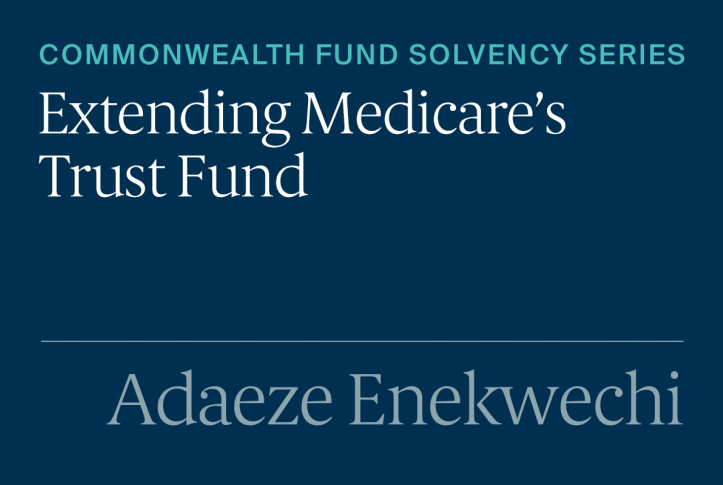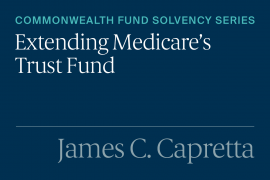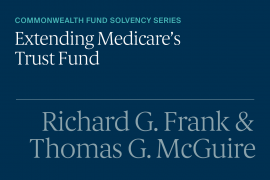The Medicare Hospital Insurance (HI) Trust Fund, which pays for Medicare beneficiaries’ hospital bills and other services, is projected to become insolvent in 2031. Without changes to expected spending or trust fund revenue, the trust fund will not have sufficient funds to cover the entire cost of beneficiaries’ health care. The HI trust fund is primarily funded through payroll taxes paid by employers and employees, with some additional income from interest as well as premiums paid by voluntary enrollees not automatically entitled to Medicare Part A. Will the trust fund solvency be extended by reducing the projected growth in expenditures, raising revenues, changes to the services covered by Medicare Part A, or a combination of these options
To stimulate policy discussions, the Commonwealth Fund asked a group of Medicare thought leaders with a variety of backgrounds and political affiliations to outline how they would extend the life of the trust fund. This series presents their perspectives, highlighting areas of commonality while also putting forth some new ideas for addressing this pressing issue.
How Will Advancing Health Equity Address Medicare Insolvency?
The Institute for Healthcare Improvement estimates that health inequities currently cost the United States $83 billion and will increase to more than $300 billion by 2050. The socioeconomic and demographic factors driving health disparities begin at birth, long before seniors age into Medicare. In order to design a payment system that is responsive to beneficiaries’ needs, Medicare must confront the poor health outcomes caused by lifelong effects of racism and structural inequities in the U.S. There has historically been underinvestment in interventions, leadership, and evidence around the most effective strategies to mitigate growing and costly inequities in our system. It is getting more costly over time to ignore this issue.
Policy Options to Advance Health Equity and Save Medicare
Medicare should articulate a vision for equity-focused health policies and select one or two achievable, high-impact goals. Policymakers must harness and use robust data, simpler and usable technology, and human creativity to direct resources.
Reduce obesity rates and improve functional ability
Reduce the share of beneficiaries who are obese by 5 percent over five years, which can save $500 million annually and $5 billion over 10 years.
Obesity has spillover effects that cause significant increases in costs to beneficiaries’ health and the health care system. Rates are disproportionately higher for racial minorities, women, rural populations, and the poor. As of 2011, Medicare provides screening and counseling for obesity but uptake of the benefit has been low. Resources that provide nutritious meals, support exercise, and facilitate group engagement can help reduce obesity.
Reduce co-occurring chronic conditions
Reducing by 5 percent the share of beneficiaries with hyperlipidemia and high blood pressure together can save the Medicare program at least $1.4 billion annually and $14 billion over 10 years. Reducing the share of beneficiaries with co-occurring conditions calls for a focused, clinical, social, and psychological approach for an effective, sustainable outcome.
These twin goals can have multiplicative benefits in reducing countless, expensive conditions and enhance the health, wellness, and longevity of millions of beneficiaries.
To make these changes, Medicare will need to:
- Take the lead on health equity. Given the size of the program and its volume of data, Medicare can steer national policy discussions toward a more nuanced understanding of the drivers of health, including structural inequities, and set the agenda for addressing them.
- Offer dynamic screening for social factors. Screen for social factors and nonmedical needs often as we would for medical diagnoses. We also should ensure we use community-based workers or licensed providers who focus on nonacute, high-touch, empathic assistance that can facilitate aging in place, combat social isolation, and augment health services with care at home.
- Combat implicit bias and enhance cultural competence among providers. Implicit bias against beneficiaries, abuse from health care providers, and feelings that clinicians do not understand beneficiaries have all contributed to wide gaps in care. Medicare pays for graduate medical education and can mandate that every resident complete antibias and cultural competence training, which would improve adherence, communication, engagement, and outcomes.
- Use sociodemographic, clinical, and encounter data. Use data that covers clinical, social, economic, and demographic variables at the individual and community levels to better understand populations and their needs. To target limited resources, Medicare needs a complete understanding of the population served and its varied needs.
- Harness technology. Decreasing health care costs will rely on the continued use of technology, such as telehealth in all its forms, to provide care quickly, cheaply, and efficiently. Forty percent of beneficiaries do not have access to broadband; beneficiaries’ access to and use of technology must evolve quickly to meet patients where they are.
New Demonstrations
Medicare has begun the process of addressing health equity, particularly with respect to end-stage renal disease and chronic kidney disease. Both conditions disproportionately affect minority populations. There are several ongoing demonstrations focused on reducing costs and improving outcomes. If effective, they could save Medicare billions while improving care for the most vulnerable beneficiaries.
There Is No Lack of Ideas; We Have Lacked Political Will
To fill the current financial gap, more traditional savings measures will need to be considered across the program. For example:
Introduce premium support or increase cost sharing. Premium support introduces additional cost sharing for beneficiaries and will provide benefits in an insurance structure to which most working Americans are already accustomed. The more exposure beneficiaries have to the true costs of care, the more likely they will use services that reflect true need. This reform would save more than $500 billion over 10 years.
Negotiate better drug prices. High health care prices, particularly drug prices, are perhaps the biggest driver of spending. A recent House bill, H.R. 3, proposed that the Secretary of the U.S. Department of Health and Human Services negotiate prices for at least 25 drugs without generic options in the Medicare Part D program, potentially saving $345 billion over five years.
An Obama-era demonstration would test a two-phase Medicare Part B drug payment model that would pay for drugs at average sales price + 2.5 percent + $16.95, and include reference pricing, indications-based pricing, risk sharing agreements, and a number of other value-based arrangements. This model was estimated to save at least 2.3 percent in Part B drug spending. It should be revisited and refined as a potential option to address drug prices.
When Congress takes up the issue of Medicare solvency, it should ensure that improving health equity with smart, dynamic, and cost-effective approaches is a key part of those efforts. Addressing the needs of the most vulnerable will not solve all the program’s fiscal challenges, nor will it remedy lifetimes of structural racism and inequities. But it could get us a long way toward stronger, healthier seniors, and a stronger and healthier Medicare program and trust fund.






